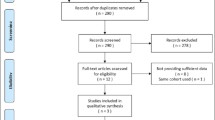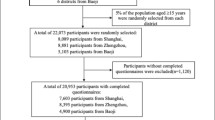Abstract
Objectives
Evidence on the topic regarding fruit and vegetable (FV) variety and health outcomes among older adults is limited. This study explored the prospective association of fruit variety, vegetable variety and combined FV variety with the risk of sarcopenia, frailty, all-cause and cause-specific mortality in community-dwelling Chinese older adults.
Design
Prospective cohort study.
Setting
Community.
Participants
Community-dwelling Chinese older adults aged ≥65 years in Hong Kong.
Measurements
Fruit variety, vegetable variety and combined FV variety at baseline were assessed using a validated food frequency questionnaire and the variety scores were stratified into tertiles. Sarcopenia (Asian Working Group for Sarcopenia 2019), frailty (Cardiovascular Health Study) and all-cause and cause-specific mortality (retrieved from an official database) were assessed at 14-year follow-up. Adjusted binary logistic regression or Cox proportional hazards model were performed to examine the association of fruit variety, vegetable variety and combined FV variety with each health outcome. Data are presented as hazard ratios (HRs) and 95% confidence intervals (CIs).
Results
Baseline dietary data of 3992 participants (median age: 72 years (interquartile range: 68–76), 49.9% women) was available. There were 436 and 371 participants who were newly identified as having sarcopenia and frailty respectively, and 1654 all-cause mortality, 367 cardiovascular diseases (CVD) mortality and 534 cancer mortality over 14-year. Tertiles of fruit variety, vegetable variety and combined FV variety were not associated with sarcopenia, frailty, CVD mortality and cancer mortality. Participants in the highest tertile of fruit variety (HR 0.81, 95% CI 0.70–0.95, p-trend 0.010), vegetable variety (HR 0.77, 95% CI 0.67–0.89, p-trend <0.001) and combined FV variety (HR 0.77, 95% CI 0.67–0.89. p-trend <0.001) showed lower risk of all-cause mortality compared with participants in the lowest tertile.
Conclusion
Among community-dwelling Chinese older adults, FV variety was not associated with sarcopenia, frailty, CVD mortality and cancer mortality over 14-year. Higher fruit variety, vegetable variety and combined FV variety were associated with a lower risk of all-cause mortality. Promoting a wide FV variety might be recommended to benefit the health and longevity of this population.
Similar content being viewed by others
References
Zhan J, Liu YJ, Cai LB, Xu FR, Xie T, He QQ. Fruit and vegetable consumption and risk of cardiovascular disease: A meta-analysis of prospective cohort studies. Crit Rev Food Sci Nutr 2017;57(8):1650–63.
Gan Y, Tong X, Li L, Cao S, Yin X, Gao C, et al. Consumption of fruit and vegetable and risk of coronary heart disease: A meta-analysis of prospective cohort studies. Int J Cardiol 2015;183:129–37.
Aune D, Giovannucci E, Boffetta P, Fadnes LT, Keum N, Norat T, et al. Fruit and vegetable intake and the risk of cardiovascular disease, total cancer and all-cause mortality-a systematic review and dose-response meta-analysis of prospective studies. Int J Epidemiol 2017;46(3):1029–56.
Lunet N, Lacerda-Vieira A, Barros H. Fruit and vegetables consumption and gastric cancer: a systematic review and meta-analysis of cohort studies. Nutr Cancer 2005;53(1):1–10.
Loef M, Walach H. Fruit, vegetables and prevention of cognitive decline or dementia: a systematic review of cohort studies. J Nutr Health Aging 2012;16(7):626–30.
Wu L, Sun D, Tan Y. Intake of fruit and vegetables and the incident risk of cognitive disorders: A systematic review and meta-analysis of cohort studies. J Nutr Health Aging 2017;21(10):1284–90.
Kojima G, Avgerinou C, Iliffe S, Jivraj S, Sekiguchi K, Walters K. Fruit and vegetable consumption and frailty: A systematic review. J Nutr Health Aging 2018;22(8):1010–7.
Wang X, Ouyang Y, Liu J, Zhu M, Zhao G, Bao W, et al. Fruit and vegetable consumption and mortality from all causes, cardiovascular disease, and cancer: systematic review and dose-response meta-analysis of prospective cohort studies. BMJ 2014;349:g4490.
Herforth A, Arimond M, Alvarez-Sanchez C, Coates J, Christianson K, Muehlhoff E. A global review of food-based dietary guidelines. Adv Nutr 2019;10(4):590–605.
Liu RH. Health-promoting components of fruits and vegetables in the diet. Adv Nutr 2013;4(3):384S–92S.
Rodriguez-Casado A. The health potential of fruits and vegetables phytochemicals: notable examples. Crit Rev Food Sci Nutr 2016;56(7):1097–107.
Soysal P, Isik AT, Carvalho AF, Fernandes BS, Solmi M, Schofield P, et al. Oxidative stress and frailty: A systematic review and synthesis of the best evidence. Maturitas 2017;99:66–72.
Robinson SM, Reginster JY, Rizzoli R, Shaw SC, Kanis JA, Bautmans I, et al. Does nutrition play a role in the prevention and management of sarcopenia. Clin Nutr 2018;37(4):1121–32.
Kim JS, Wilson JM, Lee SR. Dietary implications on mechanisms of sarcopenia: roles of protein, amino acids and antioxidants. J Nutr Biochem 2010;21(1):1–13.
Ye X, Bhupathiraju SN, Tucker KL. Variety in fruit and vegetable intake and cognitive function in middle-aged and older Puerto Rican adults. Br J Nutr 2013;109(3):503–10.
Cooper AJ, Sharp SJ, Lentjes MA, Luben RN, Khaw KT, Wareham NJ, et al. A prospective study of the association between quantity and variety of fruit and vegetable intake and incident type 2 diabetes. Diabetes Care 2012;35(6):1293–300.
Buchner FL, Bueno-de-Mesquita HB, Ros MM, Overvad K, Dahm CC, Hansen L, et al. Variety in fruit and vegetable consumption and the risk of lung cancer in the European prospective investigation into cancer and nutrition. Cancer Epidemiol Biomarkers Prev 2010;19(9):2278–86.
Tang L, Lee AH, Su D, Binns CW. Fruit and vegetable consumption associated with reduced risk of epithelial ovarian cancer in southern Chinese women. Gynecol Oncol 2014;132(1):241–7.
Tao L, Xie Z, Huang T. Dietary diversity and all-cause mortality among Chinese adults aged 65 or older: A community-based cohort study. Asia Pac J Clin Nutr 2020;29(1):152–60.
Blekkenhorst LC, Lewis JR, Bondonno CP, Sim M, Devine A, Zhu K, et al. Vegetable diversity in relation with subclinical atherosclerosis and 15-year atherosclerotic vascular disease deaths in older adult women. Eur J Nutr 2020;59(1):217–30.
Wong SY, Kwok T, Woo J, Lynn H, Griffith JF, Leung J, et al. Bone mineral density and the risk of peripheral arterial disease in men and women: results from Mr. and Ms Os, Hong Kong. Osteoporos Int 2005;16(12):1933–8.
Chen LK, Woo J, Assantachai P, Auyeung TW, Chou MY, Iijima K, et al. Asian Working Group for Sarcopenia: 2019 consensus update on sarcopenia diagnosis and treatment. J Am Med Dir Assoc 2020;21(3):300–7 e2.
Fried LP, Tangen CM, Walston J, Newman AB, Hirsch C, Gottdiener J, et al. Frailty in older adults: evidence for a phenotype. J Gerontol A Biol Sci Med Sci 2001;56(3):M146–56.
Adler NE, Epel ES, Castellazzo G, Ickovics JR. Relationship of subjective and objective social status with psychological and physiological functioning: preliminary data in healthy white women. Health Psychol 2000;19(6):586–92.
Yesavage JA, Brink TL, Rose TL, Lum O, Huang V, Adey M, et al. Development and validation of a geriatric depression screening scale: a preliminary report. J Psychiatr Res 1982;17(1):37–49.
Lee H-cB, Chiu HFK, Kowk WY, Leung CM, et al. Chinese elderly and the GDS short form: A preliminary study. Clinical Gerontologist: The Journal of Aging and Mental Health 1993;14(2):37–42.
Prince M, Acosta D, Chiu H, Scazufca M, Varghese M, Dementia Research G. Dementia diagnosis in developing countries: a cross-cultural validation study. Lancet 2003;361(9361):909–17.
Washburn RA, Smith KW, Jette AM, Janney CA. The Physical Activity Scale for the Elderly (PASE): development and evaluation. J Clin Epidemiol 1993;46(2):153–62.
Woo J, Leung SSF, Ho SC, Lam TH, Janus ED. A food frequency questionnaire for use in the Chinese population in Hong Kong: Description and examination of validity. Nutrition Research 1997;17(11):1633–41.
Paul AA, Southgate DAT. McCance and Widdowson’s The Composition of Foods. 4th edition: H.M. Stationery Office, London; 1978.
Yang Y, Wang G, Pan X. China Food Composition 2002: Peking: University Medical Press; 2002.
Centre for Health Protection, Department of Health, The Government of the Hong Kong Speical Administrative Region. Other Frequently Asked Questions about Fruits and Vegetables 2018. https://www.chp.gov.hk/en/static/90028.html. Accessed 11 November 2020
Marshall AN, van den Berg A, Ranjit N, Hoelscher DM. A scoping review of the operationalization of fruit and vegetable variety. Nutrients 2020;12(9):2868.
Heymsfield SB, Smith R, Aulet M, Bensen B, Lichtman S, Wang J, et al. Appendicular skeletal muscle mass: measurement by dual-photon absorptiometry. Am J Clin Nutr 1990;52(2):214–8.
Chan R, Leung J, Woo J. A prospective cohort study to examine the association between dietary patterns and sarcopenia in Chinese community-dwelling older people in Hong Kong. J Am Med Dir Assoc 2016;17(4):336–42.
Chan R, Leung J, Woo J. Dietary patterns and risk of frailty in Chinese community-dwelling older people in Hong Kong: A prospective cohort study. Nutrients 2015;7(8):7070–84.
Chan RSM, Yu BWM, Leung J, Lee JSW, Auyeung TW, Kwok T, et al. How dietary patterns are related to inflammaging and mortality in community-dwelling older Chinese adults in Hong Kong — A prospective analysis. J Nutr Health Aging 2019;23(2):181–94.
Kim S, Haines PS, Siega-Riz AM, Popkin BM. The Diet Quality Index-International (DQI-I) provides an effective tool for cross-national comparison of diet quality as illustrated by China and the United States. J Nutr 2003;133(11):3476–84.
Woo J, Cheung B, Ho S, Sham A, Lam TH. Influence of dietary pattern on the development of overweight in a Chinese population. Eur J Clin Nutr 2008;62(4):480–7.
Hernandez Morante JJ, Gomez Martinez C, Morillas-Ruiz JM. Dietary factors associated with frailty in old adults: A review of nutritional interventions to prevent frailty development. Nutrients 2019;11(1):102.
Granic A, Sayer AA, Robinson SM. Dietary patterns, skeletal muscle health, and sarcopenia in older adults. Nutrients 2019;11(4):745.
Jeurnink SM, Buchner FL, Bueno-de-Mesquita HB, Siersema PD, Boshuizen HC, Numans ME, et al. Variety in vegetable and fruit consumption and the risk of gastric and esophageal cancer in the European Prospective Investigation into Cancer and Nutrition. Int J Cancer 2012;131(6):E963–73.
D’Souza MJ, Li RC, Gannon ML, Wentzien DE. 1997–2017 Leading causes of death information due to diabetes, neoplasms, and diseases of the circulatory system, issues cautionary weight-related lesson to the US Population at Large. IEEE Netw 2019;2019:1–6.
Pieroth R, Paver S, Day S, Lammersfeld C. Folate and its impact on cancer risk. Curr Nutr Rep 2018;7(3):70–84.
Reuter S, Gupta SC, Chaturvedi MM, Aggarwal BB. Oxidative stress, inflammation, and cancer: how are they linked. Free Radic Biol Med 2010;49(11):1603–16.
Claesson MJ, Jeffery IB, Conde S, Power SE, O’Connor EM, Cusack S, et al. Gut microbiota composition correlates with diet and health in the elderly. Nature 2012;488(7410):178–84.
Kim S, Jazwinski SM. The gut microbiota and healthy aging: A mini-review. Gerontology 2018;64(6):513–20.
Funding
Funding: This work was supported by grants from the Hong Kong Jockey Club Charities Trust. We thank the generous donation of Ms. Therese Pei Fong Chow.
Author information
Authors and Affiliations
Corresponding author
Ethics declarations
Conflicts of interest: The authors declare no conflicts of interest. The funders had no role in the design of the study; in the collection, analyses, or interpretation of data; in the writing of the manuscript, or in the decision to publish the results.
Ethical standards: This study was approved by the Clinical Research Ethics Committee of the Chinese University of Hong Kong. All participants provided written informed consent.
Electronic supplementary material
Rights and permissions
About this article
Cite this article
Yeung, S.S.Y., Zhu, Z.L.Y., Chan, R.S.M. et al. Prospective Analysis of Fruit and Vegetable Variety on Health Outcomes in Community-Dwelling Chinese Older Adults. J Nutr Health Aging 25, 735–741 (2021). https://doi.org/10.1007/s12603-021-1605-7
Received:
Accepted:
Published:
Issue Date:
DOI: https://doi.org/10.1007/s12603-021-1605-7




